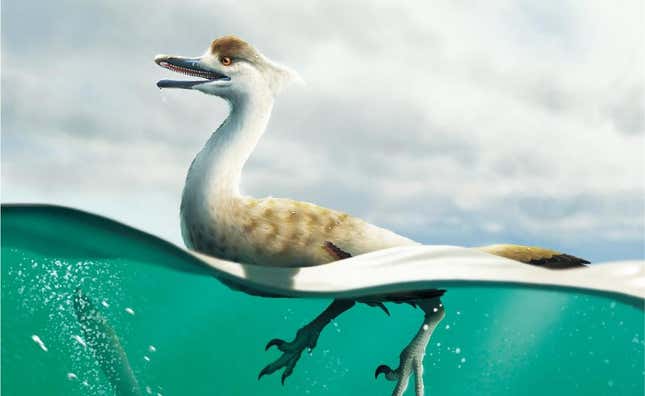
Paleontologists discovered a 71-million-year-old carnivorous dinosaur in Southern Mongolia that they believe had a body built for swimming and diving for prey. Though it looks a lot like a modern bird, it’s actually a non-avian dinosaur, meaning it’s likely an example of convergent evolution, a phenomenon in which unrelated creatures evolve similar traits.
The dinosaur is called Natovenator polydontus, or “swimming hunter with many teeth.” Recent analysis of its fossilized remains indicate the animal was bipedal and built for diving. A full description of the newly discovered animal is published in Communications Biology.
“Finding semi-aquatic dinosaurs means that the ecological diversity was very high in dinosaurs,” Yuong-Nam Lee, a paleontologist at Seoul National University and the lead author of the study, wrote in an email to Gizmodo. “More than 30 different lineages of tetrapods have independently invaded water ecosystems. Why not for dinosaurs?”

Besides its many teeth, N. polydontus had a slender body and a long neck. From the rump up, the extinct dinosaur may have looked a lot like a goose or a cormorant, a modern diving bird, but it had a long tail. The skeleton is incomplete—the researchers found its skull, spine, a forelimb, and some of two hindlimbs—but animal’s morphology could be deduced from the found remains.
“The angle between each rib shaft and its associated articulating vertebra is very low, like many diving birds, but in contrast to terrestrial theropods,” Lee said. “Certain extant diving birds–such as alcids and phalacrocoracids–also have posteriorly extending ribs. In these animals, backward-oriented ribs aid swimming by making the body more streamlined.
Lee’s team hopes they can find the stomach contents of the bird, to learn more about its diet. That sort of discovery is not without precedent; last year, paleontologists found the fossilized marine equivalent of a turducken in modern-day Germany.
Also last year, a different team made up of many of the same researchers behind the new paper announced the discovery of an armored ankylosaur from the same region in Mongolia. They posited that the ankylosaurs may have dug defensive trenches when threatened, much like modern horned lizards.
More fossils will need to be found to better test these ideas, but taken together, the fossils are showing the dynamism of biodiversity in the Cretaceous.
More: Paleontologists Find Evidence of Dinosaurs Nesting Near the North Pole